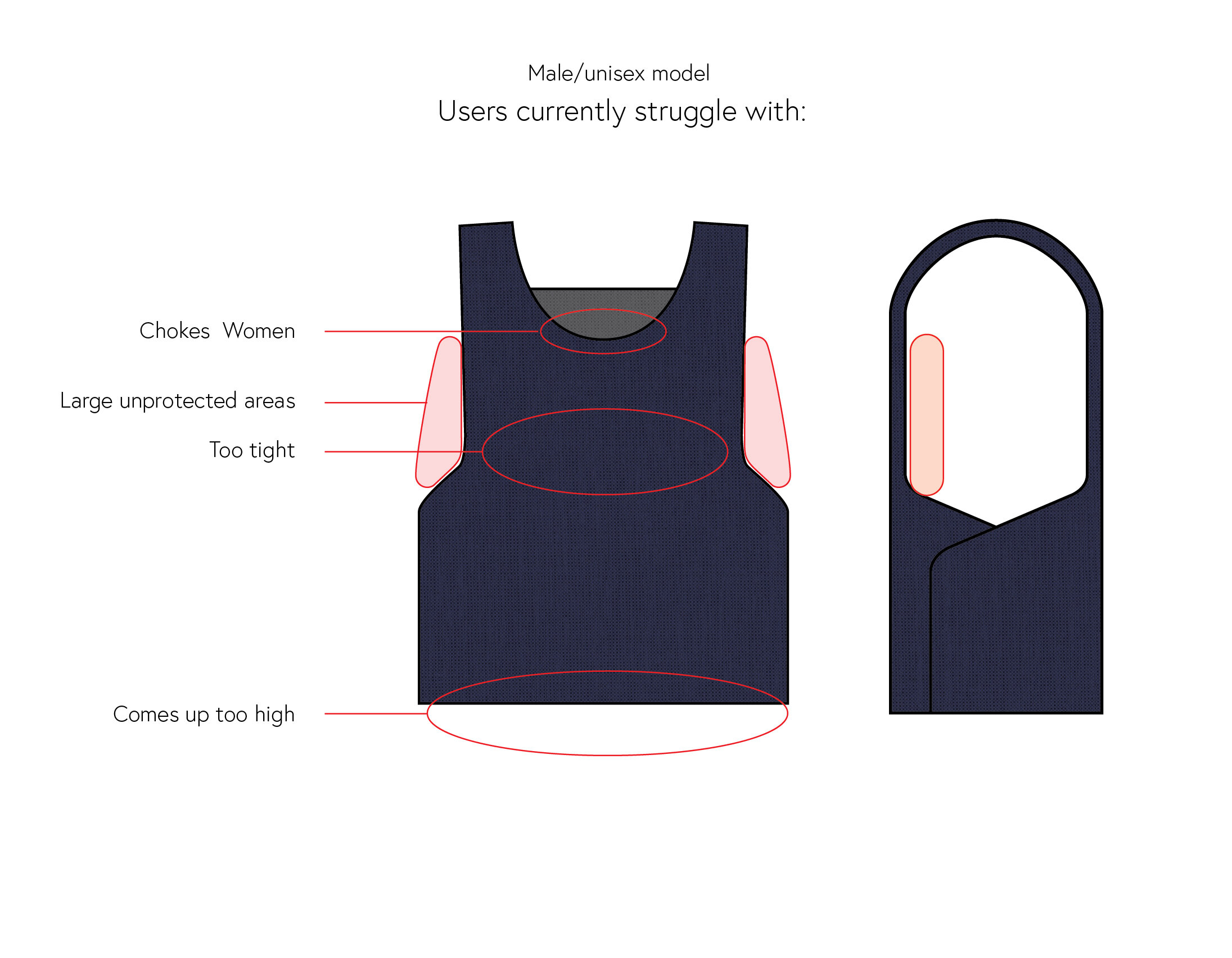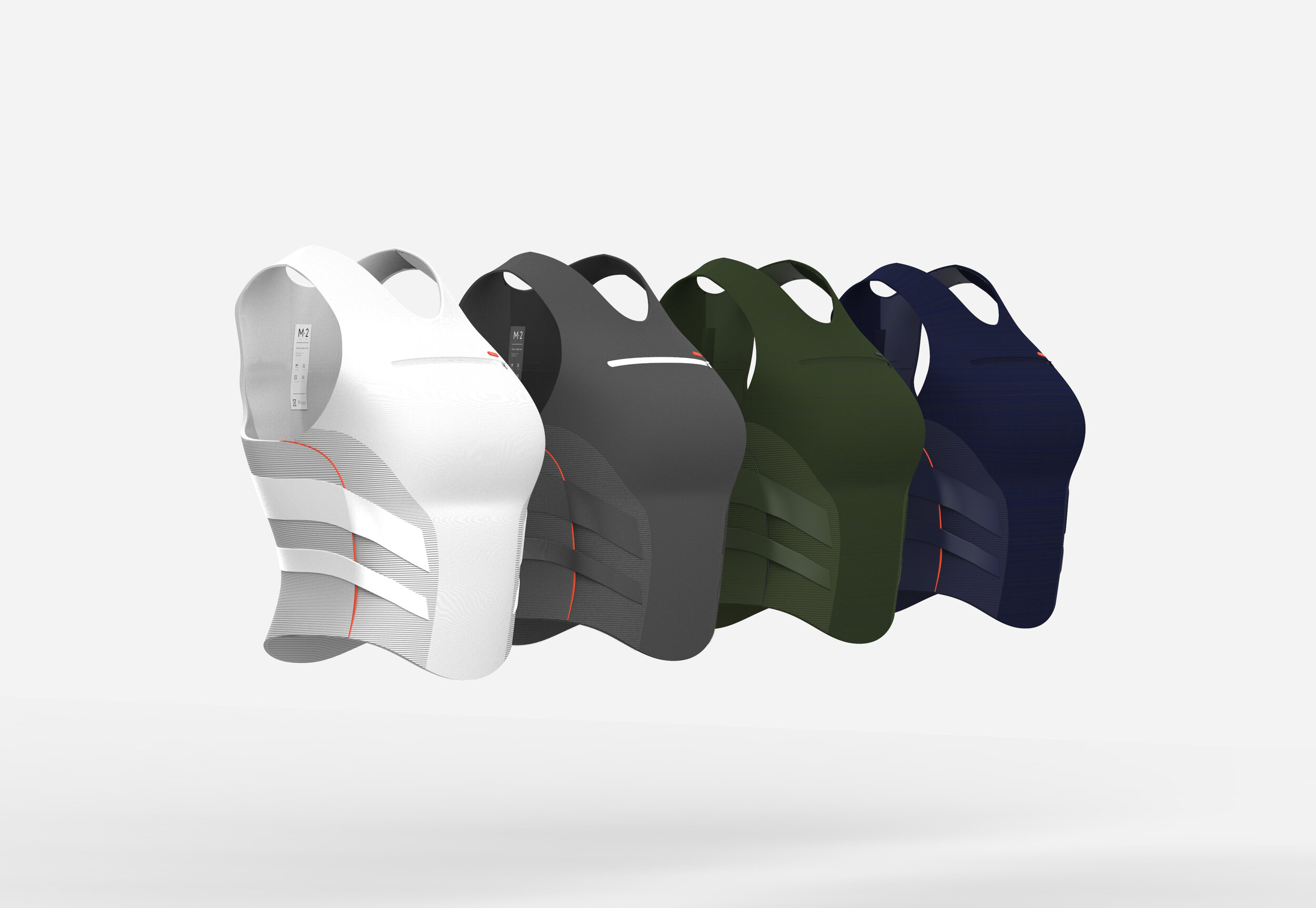
Pivot
Concealable Women’s Soft Body Armor
Incentive
Many women working at the front lines to protect our society are put in great danger on a daily basis. The body armor they are wearing are designed for ‘standard’ male bodies. Wearing these often ill-fitting vests is not only uncomfortable but also a significant safety and health issue, leaving large areas of the body unprotected, hampering movement, and hurting women’s bodies.
Design
Pivot brings a turning point in the outdated unisex approach for Personal Protective Equipment (PPE). Pivot is a concealable soft bulletproof vest, designed to fit the anthropomorphic characteristics of women’s bodies. Pivot provides optimal protective coverage, maximizes women’s mobility, and increases women’s comfort significantly.
Details
Personal project
2020
Duration: 10 days
Mini essay
What designers can do to design for gender equality,
And why it is important.
As designers, we have a substantial influence on the world and how it is shaped. This manifests itself in sometimes good, and, sometimes not so good ways. In the past months, I have emerged myself in the topic of gender equality, and its implications for the field of design. I came to the conclusion that we are not doing as well as I thought we were.
Our widely adopted, unisex design approach, which uses the standard (western) male, to design our spaces, cars, and algorithms around is letting women, (and sometimes men too) down. It has led Google Translate to believe “doctor” is male. It makes women 47% more likely to get seriously injured in a car crash, and it enables voice recognition software to 70% more accurately recognize male speech than female speech (say what now?)(4).
Why if 50% of our world's population is female, do we not see them as equally important during the design process? And more importantly, what can we do about this?
This male bias is deeply rooted in our society, however, it is time to recognize that times have changed, women do drive cars now, and they are doctors, police officers, and firefighters. So let's adjust our design process accordingly, and design for these women too.
I believe that in order to design better products, diversity in design teams is of invaluable worth. Having men, women, and people from different ethnicities on a design team enables us to catch mistakes early on in the process and will help us to create more successful designs. The more diverse the team, the fewer blind spots we have.
Of course, this is not always easily achieved, so a good second resort is found in user-testing & user research. Empathy comes a long way, but having a diverse/complete group of people to represent your users can teach us things beyond our imagination.
In some cases, designing for gender equality will come with added costs. In a world where women are just as important as men, designing for women should no longer be seen as a “niche” that is not worth extra money. I think we can all agree that designing for gender equality creates better products, and in some cases, might be worth arguing for.
Lastly, for me personally, doing some research on the topic of gender equality has really opened my eyes, and I would love to share some of my sources with you. Therefore, I have listed some of my favorite resources at the bottom of this page.
Designing a body armor for women
One of those resources is the book Invisible Women - exposing data bias in a world designed for men, by Caroline Criado Perez. When reading Invisible Women, I saw hundreds of inspiring design challenges, of which one struck me the most: the design of the body armor.
In 2020 the majority of Personal Protective Equipment (PPE) is still being designed for the male body. Unfortunately, the body armor, designed to protect people from being harmed or even killed by gunfire, is no exception.
71% Of the women working in emergency services wear PPE that is not designed for the female body. Wearing unisex, often ill-fitting vests, is a significant safety and health issue, leaving large areas of the body unprotected, hampering movement and hurting women’s bodies. (2)
As a female designer, this didn't sit well with me, so I took matters into my own hands and created Pivot, a concealable women’s body armor for police, security & emergency services.
One size does not fit all
Pivot is shaped to optimally fit the anthropomorphic characteristics of women’s bodies. Each size comes with three variable chest sizes, because one size does not fit all when it comes to body armor. It has diagonal straps to neatly fit around women's naturally tighter waist and it has raised sides on the bottom for freedom of movement in the hips.
“Mine makes me feel incredibly squashed in the chest area even though it is shaped. They seem to be one size fits all in the chest which clearly isn’t the case!”(1)
For extra protection, traditional vests often come with an insertable “hard rifle plate”, a flat piece of steel or ceramic. Pivot recognizes that for women, a flat insert is not the way to go, and suggests using proportionally shaped rifle plates that increase the freedom of movement and reduce strain on women's bodies.
Pivot is just an example of how a problem caused by a “unisex approach” could potentially be solved through design, and I hope it sparks some imagination. I would like to leave you with one final thought. The next time we design something, let’s ask ourselves, “Am I excluding 50% of the world population here?”.

Design question
“How to design a women’s body armor that provides optimal protective coverage, maximizes mobility and fits comfortably?”
Market analysis
Research
71%
of women in emergency services wear male/unisex designed PPE
“I would describe my stab vest as similar to a crop top. It is not designed to fit my breasts and despite numerous attempts to adjust it to fit it still doesn’t. There is no side protection at all and the gap left at the top above my breasts is large enough to fit another pair of breasts.”
Of the 29% of women that do get to wear “shaped” vests, the majority still do not fit properly
“Mine makes me feel incredibly squashed in the chest area even though it is shaped. They seem to be one size fits all in the chest, which clearly isn’t the case!” (1)
The Problem
Availability
Only 29% of women wear PPE especially designed for women(2).
Hindrance
95% of women in emergency services are hampered in their work by ill-fitted PPE(2).
Safety issues
Vests leave women unprotected , not covering them properly, and they make it hard for female officers to reach their guns & handcuffs(3).
Health issues
Women suffer from severe pains in back torso and breasts due to inappropriate vests, sometimes leading to surgeries or physiotherapy(1).

Design Process
“Designing a body armor that fits the anthropomorphic characteristics of women’s bodies. ”
Defining Form Language
When defining the form language it was key to create a sporty, yet neutral look. It was key to not over emphasize the femaleness of the design. The vest is concealable, meaning most of the time it will go under clothing, so the surface had to be as smooth as possible. Even though the vest is concealable it might still be worn on top of the clothes from time to time, therefore the vest will be made available in four different colors, a suitable color for each front-line profession.
White
Black
Sketching
Meet Pivot
A turning point in the male-oriented design ethos around Personal Protective Equipment
Bulletproof - layering
The vest is made bulletproof by means of stacking many different layers of fabric on top of each other. By combining different types of ballistic fabrics, different sizes of weave, and various directions of weave, the force of the bullet is optimally dispersed over the surface of the vest. By spreading the energy of the bullet, it is stopped, and the impact on the body is minimized
Advantages of pivot
Optimal protective coverage
Maximizes mobility
Comfortable
Available in 4 colors, suitable for different front-line professions
3 variable chest sizes
Sources
(1) https://www.tuc.org.uk/research-analysis/reports/personal-protective-equipment-and-women
(2) https://library.prospect.org.uk/id/2016/June/21/Women-PPE-One-Size-Does-Not-Fit-All
(3) https://www.theguardian.com/world/2016/sep/25/spain-guardia-civil-sexism-women-bulletproof-jackets
Resources:
Podcast - 99% Invisible: Podcast episode about data bias in a world designed for men
Book - Invisible women: A book about how women are often left out of design
Article: An article about equality on the designers work floor

























